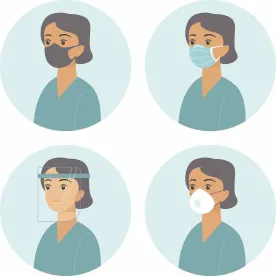On 10 June 2021, after months of anticipation by workers and the business community, the Occupational Safety and Health Administration (OSHA) issued an emergency temporary standard1 (COVID ETS) with significant implications for health care employers. When OSHA initially announced its plan to issue COVID workplace safety rules, many assumed the rules would apply across all industries, with some special guidance for healthcare employers. However, OSHA opted to limit the COVID ETS to the healthcare sector and issue separate, optional guidance for the rest of the U.S. workforce.
As discussed in more detail below, the COVID ETS mandates that certain healthcare employers develop and implement a COVID-19 plan and comply with specific regulations aimed at protecting employees from exposure to COVID-19 in the workplace. This comprehensive standard addresses a wide range of workplace safety topics and provides detailed requirements for supplying personal protective equipment (PPE) to employees, updating ventilation systems, administering employee health screenings, removing employees from the workplace due to COVID-19, and training the workforce on all COVID-19 policies. Though COVID-19 vaccinations have been the primary focus for many healthcare employers, the COVID ETS does not include a vaccination mandate. However, the COVID ETS does exempt certain healthcare workplaces from some requirements if their workforce is fully vaccinated. Similar to some of the federal legislation enacted during the pandemic, the COVID ETS also requires most covered employers to provide a form of paid leave to employees who must be removed from the workplace due to COVID-19. The COVID ETS will be effective upon publication in the Federal Register, though it is unclear when that will occur. Healthcare employers will have 14 days to comply with most of the COVID ETS, but will have 30 days to comply with those provisions related to ventilation, physical barriers, and training.
The COVID ETS imposes numerous detailed requirements on covered healthcare employers. Many of the requirements have become commonplace and healthcare employers have been following them throughout the COVID-19 pandemic. This alert will only provide a general overview of those provisions and will focus in more detail on (i) which healthcare employers are subject to the COVID ETS, (ii) the primary mandate to develop and implement a COVID-19 prevention plan, and (iii) specific requirements following employee exposure to or infection with COVID-19.
APPLICATION TO HEALTHCARE EMPLOYERS
Though touted as applying generally to “all settings where any employee provides healthcare services or healthcare support services,” many settings are excluded from the COVID ETS’ coverage. Specifically, the COVID ETS will not apply:
(i) where first aid is provided by an unlicensed healthcare provider;
(ii) to retail pharmacies;
(iii) in non-hospital ambulatory care settings where all non-employees are screened prior to entry and people with suspected or confirmed COVID-19 are not permitted to enter those settings;
(iv) in well-defined hospital ambulatory care settings where all employees are fully vaccinated and all non-employees are screened prior to entry and people with suspected or confirmed COVID-19 are not permitted to enter those settings;
(v) in home healthcare settings where all employees are fully vaccinated and all non-employees are screened prior to entry and people with suspected or confirmed COVID-19 are not present;
(vi) to healthcare support services performed outside of a healthcare setting; or
(vii) to telehealth services performed outside of a direct patient care setting.
Additionally, certain provisions of the COVID ETS addressing PPE, physical distancing, and physical barriers may not be required for fully vaccinated employees in well-defined areas where there is no reasonable expectation that a person with suspected or confirmed COVID-19 would be present.
Despite exempting certain healthcare settings where all employees are fully vaccinated, the COVID ETS does note that, in accordance with anti-discrimination laws, “where an employer reasonably accommodates an employee who is unable to be vaccinated in a manner that does not expose the employee to COVID-19 hazards (e.g., telework, working in isolation),” such employer may still fall within the applicable exemptions. Further, the COVID ETS makes clear that it is not intended to limit any state or local regulations, orders, or guidance that may impose additional requirements on employers, and employers are encouraged to comply with Centers for Disease Control and Prevention (CDC) guidance even when not required by OSHA. As with all federal workplace standards and laws, employers are prohibited from retaliating against any employee for exercising their rights under the COVID ETS or the Occupational Safety and Health Act (OSH Act).
DEVELOPING AND IMPLEMENTING A COVID-19 PLAN
The core component of the COVID ETS is the mandate for covered employers to develop a COVID-19 plan for each workplace, which must be in writing for employers with more than 10 employees. As part of the COVID-19 plan, employers must designate at least one COVID-19 safety coordinator to monitor and ensure compliance with the COVID-19 plan. In developing the COVID-19 plan, employers must conduct a hazard assessment to identify potential hazards in the workplace and must consult with non-managerial employees in this assessment and plan development. If an employer detects a COVID-19-related exposure hazard during the hazard assessment, then the employer must implement protocols to remove or mitigate the hazard. Additionally, those employers seeking an exemption from certain infection control measures due to the fully-vaccinated status of their workforce must identify protocols for verifying employees’ vaccination status.
Employers must also communicate the plan’s requirements not only to employees, but to any other employers that control the physical location where employees may be working. Further, covered employers must include health and safety protocols for employees who may enter locations not covered by the OSH Act, such as private residences or sole proprietors. Once the plan is developed, covered employers must monitor the workplace to ensure compliance and overall effectiveness, and update the COVID-19 plan as necessary. Finally, the COVID ETS mandates that employers conduct training for all employees on COVID-19 generally as well as on all policies and procedures related to reducing transmission and exposure in the workplace. Similar to other employment training requirements under state anti-discrimination laws, this training must be (i) interactive, (ii) provided to employees in a language and at a literacy level that the employee understands, and (iii) updated if any policies or procedures are modified.
GENERAL HEALTH AND SAFETY REQUIREMENTS
Many of the COVID ETS provisions reiterate current CDC guidelines related to the healthcare industry, including those addressing patient screening, standards and transmission-based precautions, cleaning and disinfection, and ventilation. Generally, these provisions aim to reduce exposure to and transmission of COVID-19 by limiting access to the workplace, implementing effective patient screening protocols, maintaining physical distancing between individuals in the workplace, erecting physical barriers in non-direct patient care areas, protecting employees during aerosol-generating procedures, requiring and providing PPE,2 and improving ventilation. Most healthcare employers have already adopted these protocols in some form, but the COVID ETS and OSHA’s ETS-related guidance provides helpful details that healthcare employers can use to improve their COVID policies and procedures.3
HEALTH SCREENING AND MEDICAL MANAGEMENT
Under the COVID ETS, employers must screen employees prior to each workday and work shift through either employee self-monitoring or in-person at the workplace. As part of its screening procedures, employers must require employees to notify them if the employee is COVID-19 positive, has been told they have or may have COVID-19, is experiencing a loss of taste and/or smell, or has a fever and new unexplained cough with shortness of breath. Within 24 hours of this notification, employers must inform different groups of employees (including those who were not wearing a respirator/required PPE and were in close contact or were in the same well-defined area during the transmission period) of potential exposure, without disclosing personal information, including the occupation, of the infected employee. Any employee who is COVID-19 positive or suspected must be removed from the workplace and may only return after satisfying certain criteria, which may include a testing requirement. Further, any employee4 who was in close contact with an infected employee must be removed and may only return after satisfying the return to work criteria.5 Employers may comply with this removal mandate by requiring employees to work remotely or in isolation if available, while continuing to pay them their regular pay and benefits.
MEDICAL REMOVAL PROTECTION BENEFITS
Though employers are no longer required to provide leave under the Families First Coronavirus Response Act, the COVID ETS requires employers with more than 10 employees to provide paid leave in the form of a medical removal protection benefit (the MRPB) to employees removed from the workplace due to COVID-19.
-
For employers with 500 or more employees the MRPB consists of regular pay and benefits up to US$1400 a week until the employee satisfies the return to work criteria.
-
For employers with fewer than 500 employees the MRPB is reduced to two-thirds of the employee’s regular pay up to US$200 per day beginning in the third week of an employee’s removal.
-
The MRPB may be reduced by any other income the employee receives during that time, such as a publicly or employer-funded leave program.
Employers are not required to provide a MRPB to employees who refuse to cooperate in the testing protocols set forth in the COVID ETS. Upon return, employees removed under the COVID ETS must be restored to their position and protected from retaliation.
VACCINATION
Despite the Biden administration’s focus on vaccinating workers, especially those in the healthcare industry, the COVID ETS does not include a vaccination mandate; instead it only requires employers to provide a form of paid time off or other leave so employees may obtain a COVID-19 vaccine. Therefore, employers in jurisdictions that do not already require some form of leave to obtain a COVID-19 vaccination must evaluate their current leave policies and ensure that employees are provided sufficient paid time off to be vaccinated and to recover from any post-vaccination symptoms.
RECORDKEEPING AND REPORTING
The COVID ETS requires employers to maintain copies of their COVID-19 plan. Employers must also create detailed logs of employees who test positive for COVID-19, recording all such information within 24 hours of learning of the positive case, and maintaining it as a confidential medical record. These logs are meant to track COVID-19 exposure regardless of whether an employee was infected in the workplace, although employers must still record work-related cases on appropriate OSHA forms. Further, these records must be available for review by employees and their representatives within one business day of a request for review. Employers must report work-related COVID-19 fatalities to OSHA within eight hours and COVID-19 hospitalizations to OSHA within 24 hours.
LEGAL AND PRACTICAL CONSIDERATIONS
Step one for all healthcare employers is determining whether their workplace is covered by the COVID ETS. If it is, employers should:
(i) assess their current policies and procedures;
(ii) conduct a hazard assessment;
(iii) develop a written COVID-19 prevention plan; and
(iv) identify relevant stakeholders who will be responsible for serving as a safety coordinator, monitoring compliance, and training the workforce in the prevention plan.
Employers intending to rely on an employee’s vaccination status to be exempt from certain requirements must include vaccination verification procedures in the COVID-19 plan and ensure that such procedures are compliant with applicable anti-discrimination laws and current agency guidelines.6
Although many healthcare employers implemented many of the health and safety protocols required under the COVID ETS early in the pandemic, the COVID ETS contains specific requirements that go above and beyond many standard COVID health and safety procedures, and employers should be sure to implement those protocols to ensure they do not run afoul of OSHA’s requirements. Chief among these new requirements, are the mandate that employers with more than 10 employees must provide compensation and benefits to employees who are removed from the workplace due to COVID-19 exposure or infection, and the directive that all employers provide paid time off for employees to be vaccinated. As these requirements may intersect with state leave laws and other leave entitlements, employers should update their leave policies accordingly.
Finally, healthcare employers should be cognizant of OSHA’s National Emphasis Program,7 effective 12 March 2021, that targets for enforcement, industries with the highest risk of exposure to COVID-19 and prioritizes hospitals, assisted living facilities, nursing homes, and other healthcare providers treating COVID-19 patients. Though OSHA has noted that it will use discretion in its enforcement for employers that are making a good faith effort to comply with the COVID ETS, covered employers will need to adhere to these new regulations to minimize the risk of an OSHA violation. Going forward, healthcare employers should work closely with healthcare and employment counsel to determine coverage, conduct a hazard assessment, develop a COVID-19 prevention plan, and ensure compliance with all aspects of the COVID ETS.
Footnotes
1 As background, OSHA is authorized to issue emergency temporary standards under limited conditions, specifically when it has determined that workers may be in grave danger and a new standard is necessary for their protection in the workplace. After initial publication in the Federal Register, the temporary standard follows the usual rulemaking procedure for a permanent standard, though the timeline for a final ruling is within six months of publication.
2 The COVID ETS addresses reasonable accommodations under the Americans with Disabilities Act and Title VII of the Civil Rights Act of 1964.
3 Additional guidance documents may be found on the OSHA website at https://www.osha.gov/coronavirus/ets.
4 This removal requirement based on close contact does not apply if the exposed employee is asymptomatic and either (1) fully vaccinated, or (2) had COVID-19 and recovered in the past three months.
5 OSHA affirmatively recognized that the CDC’s “Strategies to Mitigate Healthcare Personnel Staffing Shortages” permits “elimination of quarantine for certain healthcare workers, but only as a last resort.”
6 Please see our previous COVID-19 vaccination-related Legal Alert on vaccinations in the workplace, COVID-19: Mandatory Vaccinations: New EEOC Publication Provides Timely Guidance for Employers, December 2020.
7 See OSHA, National Emphasis Program – Coronavirus Disease 2019 (COVID-19), March 12, 2021.






 />i
/>i
